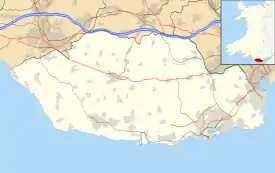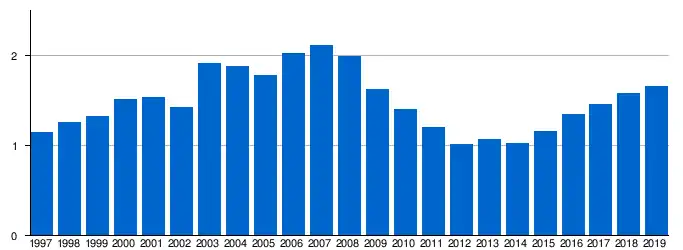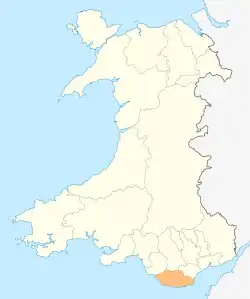Cardiff Airport
Cardiff Airport (Welsh: Maes Awyr Caerdydd) (IATA: CWL, ICAO: EGFF) is the busiest airport in Wales. It has been under the ownership of the Welsh Government since March 2013, operating at an arm's length as a commercial business. Passenger numbers were 1.66 million in 2019 and are increasing year-on-year.[2] Cardiff Airport is located near the village of Rhoose in the Vale of Glamorgan.
Cardiff Airport Maes Awyr Caerdydd | |||||||||||
|---|---|---|---|---|---|---|---|---|---|---|---|
 | |||||||||||
| Summary | |||||||||||
| Airport type | Public | ||||||||||
| Owner | Welsh Government | ||||||||||
| Operator | Cardiff Airport Ltd. | ||||||||||
| Serves | Cardiff | ||||||||||
| Location | Rhoose, Wales, UK | ||||||||||
| Opened | 2 April 1954 | ||||||||||
| Elevation AMSL | 220 ft / 67 m | ||||||||||
| Coordinates | 51°23′48″N 003°20′36″W | ||||||||||
| Website | www | ||||||||||
| Map | |||||||||||
 EGFF Location in the Vale of Glamorgan | |||||||||||
| Runways | |||||||||||
| |||||||||||
| Statistics (2019) | |||||||||||
| |||||||||||
Company
In 2013, the Welsh Government purchased Cardiff International Airport Ltd (CIAL) from TBI Ltd as a going concern for £52m.
The Welsh Government, on behalf of the Welsh Ministers, operates CIAL as an arms length public corporation, with distinct separation achieved through WGC Holdco Limited. WGC Holdco Limited was incorporated as a private company limited by shares on 21 March 2013. WGC Holdco Limited acquired CIAL on 27 March 2013.
WGC Holdco Limited owns 100 per cent of the ordinary share capital. As such, whilst CIAL is a wholly owned subsidiary of the Welsh Government, it operates in an independent and commercial manner, makes investment decisions on a commercial basis, and is liable for its own actions and any issues arising from the running of its business.
In June 2020, Wayne Harvey, the former Senior Managing Partner for Deloitte Wales, was appointed the Chairman of the airport.[3] Harvey took over from the outgoing Chair, Roger Lewis, who had served as chairman since November 2015.[4]
Since 2013, Cardiff Airport has undergone a huge transformation with improvements made to the terminal, surrounding infrastructure, customer service standards and also the introduction of new routes.
In June 2015, Europe's then-largest regional airline, Flybe opened a two aircraft base at Cardiff (3 from March 2018). The airline operated a busy flight network of 16 direct routes across the UK & Europe to destinations including Faro, Jersey, Dublin, Glasgow, Berlin, Venice, Munich, Verona, Rome, Edinburgh and Paris CDG.
History


In the early 1940s, the Air Ministry requisitioned land in the rural Vale of Glamorgan to set up a wartime satellite aerodrome and training base, named RAF Rhoose, for Royal Air Force (RAF) Spitfire pilots. Construction started in 1941, and the airfield officially began life on 7 April 1942 when it was taken over by No 53 Operational Training Unit. After WW2 the airfield fell into disuse and was abandoned.
The man who decided Rhoose could be the site of a new airport was Lord Ogmore (previously David Rees-Williams), a Bridgend-born solicitor who had served as a lieutenant-colonel in the Royal Artillery during WW2 and who was elected MP for Croydon South in 1945. In 1951 Ogmore was briefly Minister of Civil Aviation, and identified what he called a "great need for a commercial airport of international standards" in South Wales. He later told the House of Lords "a decision had to be taken whether to do nothing at all (which was the desire of some) or whether Pengam Moors, the existing airport for Cardiff, should be improved at a cost of some millions of pounds, involving the alteration of the course of the Rumney River or, thirdly, whether an entirely new airport should be constructed or acquired in the vicinity of the capital of Wales."
Lord Ogmore thought diverting the river at Pengam would be a problem, and feared that the tall chimney stacks of the nearby East Moors Steelworks could pose a safety hazard to aircraft. The Welsh Civil Aviation Consultative Committee then proposed that he should look at the "abandoned Royal Air Force airfield at Rhoose" as a possible alternative. On inspecting it, Ogmore found it "in a poor condition, with a large number of bombs stacked on the runways, and buildings in an extreme state of dilapidation". However he considered Rhoose could be suitable for civil aviation "if the necessary money and time were spent upon it". The Government accepted his proposal, and the Ministry of Aviation promptly began converting the abandoned airfield into a civilian airport. In October 1952 the new Rhoose Airport was opened by Rees-Williams's successor as Minister of Aviation Alan Lennox-Boyd.[5]
First civil flights
In 1952 Aer Lingus started a service to Dublin. Civilian flights from the old Cardiff Municipal Airport at Pengam Moors were transferred to Rhoose on 1 April 1954. A new terminal building followed, along with flights to France, Belfast and Cork. An increase in holiday charter business resulted in passenger throughput exceeding 100,000 in 1962.
On 1 April 1965 the Ministry of Aviation handed over the airport to Glamorgan County Council, and it was renamed Glamorgan (Rhoose) Airport.[6] The council started a five-year plan to develop the airport, including a new control tower, terminal building and a runway extension.[6]
In the 1970s, the supersonic airliner Concorde made a few flights into the airport on special occasions. These were limited by the length of the runway, meaning it could only land lightly loaded, and only take off without passengers and with a minimal fuel load.
In the 1980s, the airport's name was changed to 'Cardiff-Wales Airport'. 1986 saw a further extension of 750 ft (229 m) to the runway, costing in the region of £1 million, thus attracting new-generation jet aircraft to the airport. Transatlantic links were developed, with charter flights to Florida, in addition to the previously-established links with Canada. The runway extension, enabling the airport to handle 747 jumbo jets, was instrumental in attracting the British Airways (BA) maintenance facility to the airport. The maintenance hangar is one of the largest in the world at 250 m × 175 m (820 ft × 574 ft), providing heavy airframe and engineering maintenance for the British Airways fleet and third party carriers.
Privatisation
In April 1995, as a result of planned local government reorganisation in Wales, the airport company was privatised; the shares were sold to property and development firm TBI plc, which has since been converted back to a private company called TBI Ltd (a subsidiary of Abertis and AENA International). TBI Ltd also controls Luton Airport, Stockholm Skavsta, Belfast International Airport, and SABSTA (which owns three Bolivian Airports) and is concessionary to Orlando Sanford International Airport.
In December 1995, Heli-air Wales began training helicopter pilots from the airport's southside, and are widely accredited with pioneering helicopter training in Wales. Heli-air Wales moved operations to Swansea Airport in 1999, and are still operating there.
The airport is not only the main maintenance base for British Airways but also home to a variety of aerospace-oriented firms and colleges, and therefore a major contributor to the economic development of the region.
The airport was the main base for four local airlines: Cambrian Airways from 1935 to 1976, Airways International Cymru until the airline ceased operations in 1988, Inter European Airways until 1993 and Air Wales until the airline ceased scheduled operations in March 2006.
In 1996, Cardiff was one of the first airports the Irish low-cost carrier Ryanair used for its "no frills" services using second-hand Boeing 737-200s on a short hop from Dublin.
21st century
By 2006, Ryanair had withdrawn from the airport, ending five years of daily service on the Cardiff to Dublin route. The withdrawal was due to a very public falling out with the airport over charges. On 15 May 2014, it was announced that Ryanair would return to the airport after an absence of eight years, and it now operates an all-year, twice-weekly service to Tenerife in addition to three seasonal routes for summer 2019.
Following a survey conducted by the airport operator in 2008 as part of a campaign to attract additional business routes, popular destinations such as Aberdeen, Frankfurt, Düsseldorf, Brussels, and Scandinavian cities were identified as lacking a current link. The airport planned to hold up to 25 meetings with airlines during May and June 2008 to support the case for more routes.[7]
The airport was used by 2.1 million passengers in 2008, but this had fallen to around 1.3 million passengers by 2016, according to the United Kingdom Civil Aviation Authority, making it the 20th busiest airport in the UK in terms of passenger numbers.[2]
On 2 March 2009, the airport's management revealed a name change for the airport along with initial development plans to improve the image of the facility. Following a brand review involving consultation with a number of key stakeholders, the names Cardiff Airport and Maes Awyr Caerdydd replaced Cardiff International Airport.[8] Later, it emerged that the airport had applied for £5 million of payments from the Welsh Assembly Government to deal with unspecified development at the terminal. This attracted immediate public criticism and requests that the airport's owners, Abertis, match such an investment with a £6 million route development programme.[9]
It was announced on 13 April 2011 that Bmibaby were to close their base at the airport, along with their base at Manchester Airport in the following October in order to redeploy aircraft at their other bases, including the creation of a new operation at Belfast City Airport. The base closed on 30 October 2011. Regardless, the airline soon ceased operations anyway.
It was announced on 28 October 2011 that Spanish low-cost carrier Vueling were to open a new route to Barcelona, commencing 27 March 2012 and operating the route thrice weekly. Just over a month later, it was announced that Monarch were to serve Orlando Sanford Airport, Florida for the following summer, commencing the service on 28 May 2012. The airline operated the route on behalf of its own holiday wing, Monarch Holidays, and its partner company Cosmos. This was the first time in four years that there was a direct charter connection between Cardiff and the United States.
On 16 May 2012, it was announced that airport's managing director, Patrick Duffy, had left his position amid mounting pressure from the Welsh Government on the airport's owners Abertis to improve the state of the airport and improve the services it offers or else sell the facility to an investor in a proposed public-private partnership. Why Duffy left his position after four years remains unclear.[10]
On 18 December 2012, it was announced that the Welsh Government was interested in buying the airport from its current owners.[11] In 2012, the Airport faced sustained criticism from the First Minister of Wales, Carwyn Jones. On 28 February 2012, Jones announced to the Welsh Assembly: "We would like to see many routes emerging from Cardiff Airport, but the Airport must get its act together... Last week, I went to the Airport and the main entrance was shut. People could not go in through the main entrance; they had to go through the side entrance. It is important that the Airport puts itself in a position where it is attractive to new airlines, and, unfortunately, that is not the case at present." His criticism led to accusations that he was "talking down" Cardiff Airport whilst aviation industry professionals commented he was out of his depth in this area. However Jones returned to this theme on 7 March 2012 saying, "With the condition of the Airport at the moment I would not want to bring people in through Cardiff Airport because of the impression it would give of Wales...I have to say the time has come now for the owners of the Airport to decide to run the Airport properly or sell it." Byron Davies, Shadow Minister for Transport, said: "It is a bit rich for the First Minister to publicly attack and run down Cardiff Airport, when he has failed to seize opportunities, which would massively increase the range of routes available from Cardiff, introduce direct routes to North America, opening our economy to trade and business with one of the world's biggest economies".[12] Liberal Democrats spokesperson, Eluned Parrott, said: "The First Minister needs to stop talking our capital city's Airport down and instead he should be doing all he can to encourage visitors to Cardiff Airport. His comments are hardly going to encourage tourism and business to Wales."[13]
The First Minister's criticism was roundly rejected by Alex Cruz, chief executive of Vueling – a Spanish airline which operates regular flights from Cardiff. Cruz said "We are more than satisfied with Cardiff Airport. We would not fly into an Airport that we did not feel was suitable for our customers."[14] However, on 20 March 2012 Jones again criticised Cardiff Airport saying "business people" had complained to him "week after week, for many months about the Airport." He asserted he had put their points to the owners of the Airport but "they have been met with a shrug of the shoulders. That is just not good enough. I know of situations, and have seen them myself, where people have been locked in the baggage hall and where the front door was not open and people had to go in through a side door—I had to do that the last time I used the Airport."[15]
On 29 May 2012, it was announced that Jones would personally chair a "Task Force" on Cardiff Airport with the aim of "maximising its economic impact, commercially and for Wales".[16] On 27 June 2012, the Task Force, comprising tourist chiefs, local government spokesmen and trade unionists, met for the first time. No airlines were invited to attend.[17] A bid to obtain the full minutes of the meeting under the Freedom of Information Act was refused by the Information Commissioner[18]
Figures from the UK Civil Aviation Authority showed that the number of passengers passing through Cardiff Airport fell to 1 Million in 2012.[19] However, passenger numbers are increasing steadily and, as of 2017, show a recovery to pre-2010 levels.
In March 2013, the Welsh Government began the process of acquiring Cardiff Airport from TBI/Abertis, who were considering divesting all of their airport assets following international criticism of their management of these resources.[20] The deal to purchase the airfield for £52 million[21] was officially announced on 27 March 2013.
Cardiff Airport has had several problems with wild fly-grazing horses[22] around the airfield and the Redwings Sanctuary in Norfolk were needed to assist in the rescue of 23 unclaimed horses that had been left on the site.[23]
Recent developments
In June 2015, a major deal was signed with Flybe for the opening of a two aircraft base for their Embraer 195 jet aircraft which a considerable number of new routes; this deal saw the end of Cityjet flights from the airport. Flybe also announced in 2016 that it would link Cardiff with London City Airport through a temporary route from 12 September 2016 until 21 October 2016 during the temporary closure of the Severn Tunnel.[24] But due to the popularity of this service, Flybe decided that regular flights to London City Airport would continue.[25] However, on 9 August 2017, Flybe announced that the service would be terminated, and the last flight was on 27 October 2017.[26]
In April 2017, Qatar Airways announced plans to launch a new service from Cardiff Airport, linking Wales and the West of England to Doha.[27] It announced Cardiff Airport as the only new planned UK route in its network for 2018, although the resumption of Qatar Airways flights from the Middle East to London-Gatwick was also later confirmed.[28]
In 2018 the airport unveiled new ePassport gates in the terminal building to reduce queueing in immigration.
On 4 April 2019,[29] Flybe confirmed it would no longer have a permanent operational base at the airport from the end of the summer 2019 season; however due to Flybe entering administration on 5 March it ceased operations. This was a huge blow for the airport as Flybe was Cardiffs largest airline providing 27% of its annual passenger numbers in 2018 and meant a loss of its routes to Dublin, Edinburgh, Belfast, Paris, Jersey, Cork, Munich, Rome, Verona, Faro, Milan, Venice, seasonal winter services to Geneva and Chambery also Berlin and Düsseldorff which were ceased in January. Most of these routes were only served by Flybe.[30]
On 3 December 2020,[31] Wizz Air announced its fourth UK base at Cardiff, basing one Airbus A321 aircraft and launching 9 routes (Alicante, Corfu, Faro, Heraklion, Lanzarote, Larnaca, Palma, Sharm El Sheikh and Tenerife). This will make Cardiff Airport the only WizzAir base without flights to Eastern Europe.
Infrastructure
On 29 March 2006, a £100 million development strategy was announced to extend the terminal and upgrade the main body of the building. It was anticipated that the investment would attract up to five million passengers by 2015 – an increase of 150% – according to the airport's published response to a UK Government White paper on the future of air transport throughout the United Kingdom.[32]
Costing around £3m, half funded by the Welsh Government, extensive refurbishment is expected starting with the redevelopment of the front of the Airport terminal and approach areas.[33] The development works include an extension to the front of the terminal linking the arrivals and departures halls into one large common area, providing new food and retail services. As part of the work the first floor of the terminal will become 'airside' as the security control point to access the departures lounge is relocated to the first floor, above the existing arrivals hall and accessed through the new extension. The approach area in front of the terminal building will also be redesigned and landscaped.[34] Subsequently, it emerged that Cardiff Airport was seeking £5 million from Welsh taxpayers,[9] without specifying what works might be carried out.
In October 2017, works costing £4 million were announced to upgrade the terminal by expanding the departures area with increased seating and increased retail space and expand the executive lounge. Outside the terminal a new meet and greet parking facility and a new car hire terminal would be built. Work started in October 2017.[35]
In March 2020, the airport asked for a further loan of £6.8m loan-on top of £21m it received last year. [36]
Operations
Cardiff Airport is the only airport in Wales that offers international scheduled flights and is also served by scheduled, low-fare, business and charter carriers. It also supports corporate and general aviation.
On 21 February 2007 the airport announced that it would host the first Public Service Obligation (PSO) service to be operated in Wales.[37] This Welsh Government subsidised service was operated by Flybe using its franchise partner Eastern Airways with daily flights to the Isle of Anglesey.
Most international destinations from Cardiff are to other countries in Europe, including the Netherlands, Greece, and Spain. Qatar Airways announced in April 2017 that it would begin service to Doha in May 2018, using the Boeing 787 aircraft. It is now the first long-haul service from Cardiff for many years following the demise of Zoom Airlines.[38]
Airlines and destinations
The following airlines operate regular year-round and seasonal scheduled and charter flights to and from Cardiff:[39]
| Airlines | Destinations |
|---|---|
| BH Air | Seasonal: Burgas |
| Eastern Airways | Anglesey (resumes 1 March 2021),[40] Belfast–City (begins 12 March 2021)[41] |
| KLM | Amsterdam |
| Ryanair | Faro, Málaga Seasonal: Barcelona (resumes 1 May 2021),[42] |
| TUI Airways[43] | Alicante, Gran Canaria, Lanzarote, Málaga, Tenerife–South Seasonal: Antalya, Burgas, Corfu, Dalaman, Dubrovnik, Enfidha, Faro, Heraklion, Ibiza, Kefalonia, Kos, Larnaca, Menorca, Palma de Mallorca, Paphos, Reus, Rhodes, Sharm El Sheikh (begins 1 November 2021),[43] Zakynthos |
| Vueling | Alicante Seasonal: Málaga, Palma de Mallorca |
| Wizz Air[44] | Alicante (begins 28 March 2021), Faro (begins 28 March 2021), Larnaca (begins 27 March 2021), Tenerife–South (begins 26 March 2021) Seasonal: Corfu (begins 29 May 2021), Heraklion (begins 26 March 2021), Lanzarote (begins 1 October 2021), Palma de Mallorca (begins 28 March 2021), Sharm El Sheikh (begins 1 November 2021) |
General aviation
The airport was home for many years to a number of flying clubs and small general aviation operators. These included the Cambrian and Pegasus Flying Clubs and later (from the mid-1980s) the Cardiff Wales Flying Club. In 2010, a new flying school was set up by the company Aeros. They (as of 2012) have a fleet including Cessna 152s and Piper Warriors; they are based in the White Building on the south side of the airfield. There is a small cafe in the White Building that offers facilities for private aircraft owners.
Dragonfly Executive Air Charter operate three Beechcraft King Air 200 series aircraft. The company office is based on the south side of the airfield.
Traffic and statistics
Passenger figures
 |
| Updated: 7 February 2020.[2] |
| Number of Passengers[45] | Percentage Change | Number of Movements[46] | ||
|---|---|---|---|---|
| 1997 | 1,155,186 | – | 60,724 | |
| 1998 | 1,263,225 | 65,597 | ||
| 1999 | 1,330,277 | 63,740 | ||
| 2000 | 1,519,920 | 64,298 | ||
| 2001 | 1,543,782 | 67,624 | ||
| 2002 | 1,425,436 | 49,115 | ||
| 2003 | 1,919,231 | 48,590 | ||
| 2004 | 1,887,621 | 43,023 | ||
| 2005 | 1,779,208 | 43,040 | ||
| 2006 | 2,024,428 | 42,055 | ||
| 2007 | 2,111,148 | 43,963 | ||
| 2008 | 1,994,892 | 37,123 | ||
| 2009 | 1,631,236 | 27,003 | ||
| 2010 | 1,404,613 | 25,645 | ||
| 2011 | 1,208,268 | 29,130 | ||
| 2012 | 1,013,386 | 26,842 | ||
| 2013 | 1,072,062 | 24,879 | ||
| 2014 | 1,023,932 | 25,864 | ||
| 2015 | 1,160,506 | 25,077 | ||
| 2016 | 1,347,483 | 26,256 | ||
| 2017 | 1,465,227 | 28,934 | ||
| 2018 | 1,581,302 | 31,085 | ||
| 2019 | 1,654,920 | 31,880 | ||
| Source: UK Civil Aviation Authority[2] | ||||
Busiest routes
| Rank | Airport | Total passengers | Change 2017 / 18 |
|---|---|---|---|
| 1 | Amsterdam | 146,058 | |
| 2 | Palma de Mallorca | 108,313 | |
| 3 | Dublin | 108,275 | |
| 4 | Alicante | 103,671 | |
| 5 | Edinburgh | 102,372 | |
| 6 | Tenerife–South | 88,771 | |
| 7 | Málaga | 88,740 | |
| 8 | Paris–Charles de Gaulle | 77,503 | |
| 9 | Belfast–City | 71,439 | |
| 10 | Faro | 64,036 | |
Ground transport


Rail
The nearest railway station is Rhoose Cardiff International Airport railway station on the Vale of Glamorgan Line. The station has an hourly Transport for Wales service to/from the east from Cardiff Central (originating from Merthyr Tydfil) and to/from Bridgend in the west.
The railway station is 2 miles (3.2 km) from the terminal building, and the transfer is served by Rail Linc buses which operate to and from the railway station to the terminal building. the departures terminal.
Train to Terminal tickets
Customers travelling to the station by rail can purchase through tickets, which include the far bus transfer to the terminal, by purchasing a ticket for "Cardiff Air Bus" station on ticket machines, or using the National Rail code XCF.
Tickets are cheaper with the bus transfer than merely to the standard "Rhoose Cardiff" station. Through tickets are available from railway stations.
Bus
From 1 August 2013, TrawsCymru has operated the "Cardiff Airport Express" (Welsh: Gwennol Maes Awyr Caerdydd) from Cardiff Airport to Cardiff City centre with railway connections. The T9 service with leather seats runs on a 20-minute schedule and offers customers free wifi.[48] It also operates hourly throughout the night.
Road
10 miles (16 km) from the M4 junction 33 (Cardiff West), the airport is reached via the A4232, exiting at Culverhouse Cross and following the A4050 to Barry and then the A4226 towards Llantwit Major. From the west, leave at junction 37 Pyle, to join the A48 past Cowbridge and south on the A4226. There is a direct unmarked route from M4 junction 34 (Miskin) following the lanes though Hensol and at Sycamore Cross (A48) continuing on the A4226 to the airport.
Proposed A48 and rail expansion
Road access to the airport by way of the A48 was the subject of a public inquiry in 2006 but this is now superseded by needs of the forthcoming Defence Training Academy at MoD St Athan, the bid for which included plans for a direct St Athan and airport link to the M4. With the growth in usage of the airport, traffic along the current access roads has become more acute leading the Welsh Assembly Government to commission a study on improving road access to the Airport. The consultants suggested three possible schemes:
- Widening the A4232 to three lanes between M4 Junction 33 and Culverhouse. A bypass would have been built connecting the A4232 directly to the A4050 to avoid the busy Culverhouse Cross roundabout.
- Constructing a new bypass road to link the A4232 directly to the A48 (Tumble Hill) before Culverhouse Cross. Airport traffic would then have travelled to Sycamore Cross then join the A4226 to the Airport. Improvements will be made to allow speeds to increase.
- Directing traffic from Junction 34 (Miskin) to Sycamore Cross then onto the A4226 to the airport. Improvements would have been made to the route with new straighter sections added.
Airport management favoured the third option, claiming that it would have eased pressure on the A4232 and provide better access from South West Wales, the South Wales Valleys and Mid Wales, but in June 2009, the National Assembly for Wales announced that the plans for any new road would be dropped in favour of increased public transport frequency by rail and bus.[49][50] The Institute of Welsh Affairs debated the future of the project in their 2017 article "A road to Cardiff Airport... or regeneration in Pontypridd?"[51]
In 2019 it was announced that the A48 link road was to go ahead,[52] with the route announced to run from J34 of the M4 to the A48 south of Sycamore Cross through the west of Pendoylan. The proposal is also likely to include a new railway station and park and ride near Junction 34 on the South Wales Main Line near Hensol Castle.[53] The plans will include an integrated bus service between the railway station, strategic employment sites, and Cardiff Airport.[52]
See also
References
- "NATS – AIS – Home". Retrieved 2 February 2015.
- "Size of Reporting Airports 2017" (PDF).
- "New Cardiff Airport Chair begins post". www.cardiff-airport.com. Retrieved 4 June 2020.
- Barry, Sion (25 March 2015). "WRU chief executive Roger Lewis confirmed as the next chairman of Cardiff Airport". Wales Online. Retrieved 4 April 2015.
- Hansard Lords Debates 1957
- "Council Take Over An Airport". News. The Times (56286). London. 2 April 1965. col D, p. 8.
- "You Would If You Could – Survey Results". Archived from the original on 6 March 2008.
- "Airport signals change ahead". Cardiff Airport – News. 2 March 2009. Archived from the original on 16 July 2011. Retrieved 2 March 2007.
- "Assembly plans £5m air terminal upgrade". walesonline. 9 March 2011. Retrieved 2 February 2015.
- "Cardiff Airport boss Patrick Duffy leaves managing director's job". BBC News. 16 May 2012. Retrieved 4 June 2015.
- BBC News – Cardiff Airport: Welsh government plan to buy from TBI. Bbc.co.uk (18 December 2012). Retrieved on 23 July 2013.
- Cardiff-New York air route worth £200m a year to Wales, report reveals. Wales Online (19 March 2012). Retrieved on 23 July 2013.
- First Minister Carwyn Jones under fire for attack on Cardiff Airport. Wales Online (13 March 2012). Retrieved on 23 July 2013.
- First Minister Carwyn Jones' Cardiff Airport criticism rejected. Wales Online (29 March 2012). Retrieved on 23 July 2013.
- Carwyn Jones renews attack on 'not good enough' Cardiff Airport. Wales Online (20 March 2012). Retrieved on 23 July 2013.
- Cardiff Airport to be targeted by task force, says Carwyn Jones. Wales Online (29 May 2012). Retrieved on 23 July 2013.
- Archived 26 August 2012 at the Wayback Machine
- Llywodraeth Cymru | Welsh Government. Wales.gov.uk. Retrieved on 23 July 2013.
- "Archived copy" (PDF). Archived from the original (PDF) on 21 June 2015. Retrieved 21 June 2015.CS1 maint: archived copy as title (link)
- Abertis may sell UK airports as it tries to ease €14bn debt | Business. The Guardian. Retrieved on 23 July 2013.
- BBC News – Cardiff Airport is sold to the Welsh government for £52m. Bbc.co.uk (27 March 2013). Retrieved on 23 July 2013.
- "This is where owners graze horses on private land without the landowner's permission. The horses may not be abandoned.", Welfare Matters edition 11 Archived 11 May 2012 at the Wayback Machine, page 2
- "Fly-grazing horses at 'crisis point' in Wales". BBC News. 21 February 2012.
- "FLYBE FAST TRACKS NEW FLIGHTS TO LONDON CITY FROM CARDIFF". www.flybe.com.
- "Cardiff-London flights to continue". BBC News. 17 October 2016.
- "News". www.cardiff-airport.com.
- "Qatar Airways chooses Cardiff Airport". www.cardiff-airport.com.
- "Cardiff Airport unveils Qatar flights". BBC News. 24 April 2017.
- "Flybe confirms it will no longer have a permanent base at Cardiff Airport". 4 April 2019 – via www.walesonline.co.uk.
- https://www.walesonline.co.uk/business/business-news/exactly-what-flybe-leaving-cardiff-16074829
- "Wizz Air announces further UK expansion with new base at Cardiff Airport". 3 December 2020 – via www.cardiff-airport.com.
- "The Future of Air Transport – White Paper and the Civil Aviation Bill, Chapter 6, Wales". UK Department for Transport. 10 December 2004. Archived from the original on 9 June 2007. Retrieved 2 July 2007.
- "Passenger Terminal Today". Archived from the original on 3 April 2015. Retrieved 2 February 2015.
- "Cardiff Airport upgrade set to get green light". walesonline. 22 January 2010. Retrieved 2 February 2015.
- "£4million projects to be complete by summer 2018 at Cardiff Airport". www.Cardiff-Airport.com. Retrieved 14 January 2018.
- "Cardiff Airport asks for £6.8m loan". Walesonline. 20 March 2020.
- "North-south airline is revealed". BBC News. 21 February 2007.
- "Qatar Airways launches daily flights from Cardiff to the World". www.cardiff-airport.com.
- cardiff-airport.com - Destinations retrieved 5 October 2016
- https://www.easternairways.com/announcements/coronavirus-information
- https://t3-prodibe.avantik.io/B2C/en/Home/Availability/CWL/BHD/20210111/20210118/1/0/0/0/GBP/True/0/B2C#!
- https://www.ryanair.com/gb/en
- "Flight Timetable". tui.co.uk.
- "Wizz Air announces further uk expansion with new base at Cardiff Airport". cardiff-airport.com. 3 December 2020.
- Number of Passengers including both domestic and international.
- Number of Movements represents total aircraft takeoffs and landings during that year.
- "Airport data 2017 | UK Civil Aviation Authority". UK Civil Aviation Authority. Tables 12.1(XLS) and 12.2 (XLS). Retrieved 21 March 2018.
- "Archived copy" (PDF). Archived from the original (PDF) on 24 December 2013.CS1 maint: archived copy as title (link)
- walesonline Administrator (10 July 2008). "Airport access plans await clearance". walesonline. Retrieved 2 February 2015.
- "BBC NEWS – UK – Wales – M4 and airport road plans dropped". 15 July 2009. Retrieved 2 February 2015.
- "A road to Cardiff Airport…or regeneration in Pontypridd?". Click on Wales. 21 July 2017. Retrieved 9 September 2019.
- Pyke, Chris (16 April 2018). "Exact routes for new road linking M4 and A48 revealed". walesonline. Retrieved 9 September 2019.
- Discombe, Matt (2 April 2019). "Preferred route for controversial M4 to A48 link road revealed". walesonline. Retrieved 9 September 2019.

